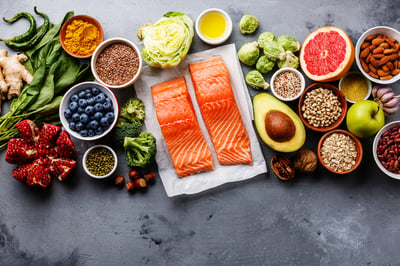Do you ever find it difficult to determine if your favorite foods are actually healthy for you?
Between misleading labels and the never-ending supply of ‘healthy’ foods on every supermarket shelf, eating healthy can be a confusing and even daunting task.
What is Considered “Healthy Food”?
While eating fads come and go, there are a few key elements to healthy eating that remain unchanged.
Here is what we know:
"Healthy Food” Defined
Healthy foods are those that provide you with the nutrients you need to sustain your body’s well-being and retain energy. Water, carbohydrates, fat, protein, vitamins, and minerals are the key nutrients that make up a healthy, balanced diet.
Facts You Should Know:
- Only 1 in 10 adults meet the daily recommendation for fruit and vegetable intake
- Fruits and Vegetable Serving Sizes
This information tells us we need to focus on eating fresh foods that provide us with the nutrients our bodies need.
Unfortunately, the food industry doesn’t make as much of a profit on fresh foods; processed foods are where the money's at. Even big food companies have lobbied aggressively against public health plans - such as a campaign ordering the removal of junk food from schools.
These junk food items, processed from crops such as corn, wheat, and soybeans, are high in calories (fillers) and lack the nutritional value your body needs. However, because they are derived from crops, it can be difficult to know if they are healthy or not, and misleading claims on labels only make things worse.
How to Read Food Labels
According to a recent Nielsen report, almost 60-percent of consumers misinterpret or have a hard time comprehending nutrition labels.
One of the most critical parts of reading your food labels is to look at the serving size; 160 calories may not seem like much, but that could be for only two little cookies. Continue reading for other factors to keep in mind when grocery shopping for your healthy foods.
Saying “zero trans fat”, “all natural”, or “contains whole wheat” can trick you into thinking the product is healthy, even when its nutritional value has been stripped away after being processed.

Alternatively, many packaged products are packed with salt, sugar, and saturated fat. In other words, these claims make you forget about the added calories. Here is a list of what you should know before you read your food’s nutritional facts:
- Sugar: Women should try to limit their sugar intake to 25 g / day or 6 teaspoons
- Fat: There are about 9 calories per gram of fat - stick to about 50 g / day
- Sodium: Women should not consume more than 1,500 mg or 3.8 g of salt / day
- Protein: Women exercising less than 30 min / day should eat about 46 g of protein / day
- Vitamins: Naturally occurring vitamins are ideal, but added vitamins can be helpful too
- Calories: The average amount for women is 2,000 / day and 1,500 / day to lose weight based on a 150 lb. woman
As women between the ages of 35 and 50, not knowing what is good or bad for your body can create unwarranted stress. Use the following as a resource to ease the worries that come along with taking the right steps to strengthen your future health.

Comments
Post a Comment